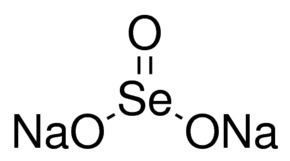Formula Na2SeO3 Appearance colourless solid | Melting point 320 °C | |
 | ||
Related compounds | ||
Sodium selenite is the inorganic compound with the formula Na2SeO3. This salt is a colourless solid. The pentahydrate Na2SeO3(H2O)5 is the most common water-soluble selenium compound.
Contents
Synthesis and fundamental reactions
Sodium selenite usually is prepared by the reaction of selenium dioxide with sodium hydroxide:
SeO2 + 2 NaOH → Na2SeO3 + H2OThe hydrate converts to the anhydrous salt upon heating to 40 °C.
Akin to the related salt sodium sulfite, Na2SeO3 features a pyramidal dianion SeO32−. Oxidation of this anion gives sodium selenate, Na2SeO4.
Applications
Together with the related barium and zinc selenites, sodium selenite is mainly used in the manufacture of colorless glass. The pink color imparted by these selenites cancels out the green color imparted by iron impurities.
Because selenium is an essential element, sodium selenite is an ingredient in some food supplements.
The US Food and Drug Administration approved a selenium supplement to animal diets, however the most common form is sodium selenite for pet foods. According to one article, "not much was known about which selenium compounds to approve for use in animal feeds when the decisions were made back in the 1970s .. At the time the regulatory action was taken, only the inorganic selenium salts (sodium selenite and sodium selenate) were available at a cost permitting their use in animal feed.”
Safety
Selenium is toxic in high concentrations. The chronic toxic dose for human beings is about 2.4 to 3 milligrams of selenium per day.
